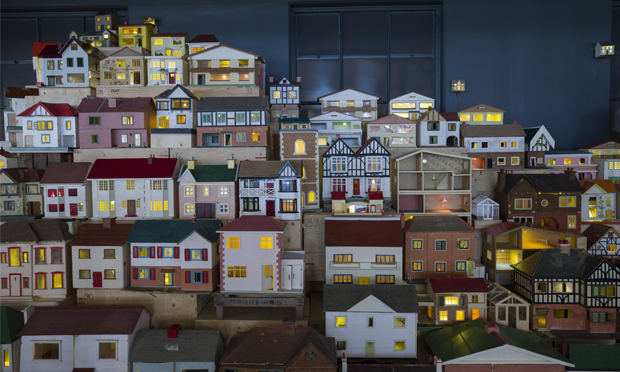Rachel Whiteread’s Place (Village) added to Museum of Childhood

Part of Place (Village) by Rachel Whiteread, in situ at the Museum of Childhood. Photograph: Victoria and Albert Museum, London.
A sculpture by Turner prize winning artist Rachel Whiteread has been added to the permanent collection at the Victoria & Albert Museum of Childhood.
The piece Place (Village) was created over two years, however Whiteread spent 20 years sourcing and collecting the mismatched assortment of approximately 150 houses that make up the sculpture.
The architecture within the display ranges from Tudor cottages to more Modernist designs and includes both hand-made and manufactured dolls houses which Whiteread predominantly sourced online.
Commenting on her piece being given a permanent place in the museum’s already extensive collection of dolls houses, Whiteread said: “I am pleased that Place has found a permanent home in Bethnal Green, as I have lived and worked in East London for many years and know the Museum of Childhood well.
“This work connects to my earlier work because these houses have no people in them and there is no furniture. I was interested in the interiors of these houses and also the fact that they had been through many generations of family. They may have been made by the father. There was a lot of love involved with them and then eventually the love was lost. They were transferred through generations. That transaction is always something that’s been in my work. The things that I’ve worked with have all been used, had a life before.”
It feels as though the love is being returned to them through the choice to display Place in this particular museum. Whether this was intentional or not, there is something moving about these once unwanted, forgotten items being given a permanent place where they can be appreciated by hundreds of children on a daily basis. This is echoed by the return of the piece to it’s place of origin, East London.
The installation is positioned in a darkened corner of the museum, to allow the lights inside the houses to glow as the artist had originally intended.
Though the interiors to the houses remain empty, Whiteread’s concept of creating an eerie, haunted village seems to be jettisoned somewhat in its new setting. The Museum of Childhood does not have the same atmosphere as a quiet gallery and the environment seems to alter the way the piece is viewed. It changes the nature the work, and the once supposedly ghostly village looks more warm and welcoming than desolate or remote. The museum is constantly full of the sound of children playing and this brings new life to the installation.
The work was first shown in Naples in 2007, a locale which reminded Whiteread of Hackney. In 1993 the artist was awarded the Turner prize for her piece House, a concrete cast of the interior of a three-story house which was shown in Wennington Green and left on display there for eleven weeks.
Place (Village) is on display at the Victoria & Albert Museum of Childhood, Cambridge Heath Rd, E2 9PA
